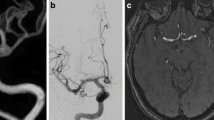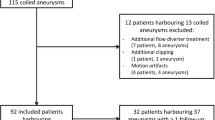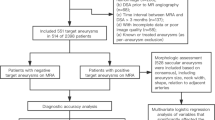Abstract
Even with the advent of endovascular treatment for intracranial aneurysms, microsurgical clipping continues to play a significant role in the treatment of middle cerebral artery (MCA) aneurysms. Securing perforators around unruptured intracranial aneurysms (UIAs) is essential for minimizing procedural risks in each treatment option. Therefore, we herein investigated whether the findings of high-resolution cone-beam computed tomography (HR-CBCT) have an impact on decision-making for the treatment of MCA UIAs. Patients with MCA UIAs between October 2017 and September 2021 were consecutively recruited for this study. All patients underwent HR-CBCT and 3D-DSA before treatment. The imaging quality of both modalities to visualize the microvasculature around aneurysms was evaluated. Specific findings on the microvasculature surrounding aneurysms on HR-CBCT were investigated to facilitate microsurgical clipping. Fifty-two MCA UIAs were treated, including 43 by microsurgical clipping and 9 by endovascular approaches. The overall imaging quality of HR-CBCT was superior to that of 3D-DSA. Regarding microsurgical insights, sensitivity and specificity for the visualization of small vessels around aneurysms were 79 and 100%, respectively, using HR-CBCT, and 57 and 93%, respectively, using 3D-DSA. The presence of a low-density band between adhesive vessels and aneurysm sacs was indicative of successful and safe microsurgical dissection between these structures. HR-CBCT enabled visualization of the intracranial microvasculature around MCA UIAs at the submillimeter level in vivo. In cases in which the tight adhesion of the microvasculature to the aneurysm sac is indicated by HR-CBCT, an endovascular approach may be considered in order to avoid the risks associated with securing perforators.



Similar content being viewed by others
References
Morita A, Kirino T, Hashi K et al (2012) The natural course of unruptured cerebral aneurysms in a Japanese cohort. N Engl J Med 366:2474–2482
McDonald JS, McDonald RJ, Fan J et al (2013) Comparative effectiveness of unruptured cerebral aneurysm therapies: Propensity score analysis of clipping versus coiling. Stroke 44:988–994
Alreshidi M, Cote DJ, Dasenbrock HH et al (2018) Coiling versus microsurgical clipping in the treatment of unruptured middle cerebral artery aneurysms: A meta-analysis. Neurosurgery 83:879–889
Smith TR, Cote DJ, Dasenbrock HH et al (2015) Comparison of the efficacy and safety of endovascular coiling versus microsurgical clipping for unruptured middle cerebral artery aneurysms: A systematic review and meta-analysis. World Neurosurg 84:942–953
Zijlstra IA, Verbaan D, Majoie CB et al (2016) Coiling and clipping of middle cerebral artery aneurysms: A systematic review on clinical and imaging outcome. J Neurointerv Surg 8:24–29
Darsaut TE, Keough MB, Boisseau W et al (2022) Middle cerebral artery aneurysm trial (MCAAT): A randomized care trial comparing surgical and endovascular management of MCA aneurysm patients. World Neurosurg 160:e49–e54
Chung J, Hong CK, Shim YS et al (2015) Microsurgical clipping of unruptured middle cerebral artery bifurcation aneurysms: Incidence of and risk factors for procedure-related complications. World Neurosurg 83:666–672
Lee HS, Kim M, Park JC et al (2021) Clinical features of ischemic complications after unruptured middle cerebral artery aneurysm clipping: Patients and radiologically related factors. Neurosurg Rev 44:2819–2829
Nussbaum ES, Madison MT, Goddard JK et al (2018) Microsurgical treatment of unruptured middle cerebral artery aneurysms: A large, contemporary experience. J Neurosurg 130:1–7
Matsukawa H, Kamiyama H, Miyazaki T et al (2019) Comprehensive analysis of perforator territory infarction on postoperative diffusion-weighted imaging in patients with surgically treated unruptured intracranial saccular aneurysms. J Neurosurg 132:1088–1095
Lee KS, Zhang JJY, Nguyen V et al (2022) The evolution of intracranial aneurysm treatment techniques and future directions. Neurosurg Rev 45:1–25
Lylyk I, Scrivano E, Lundquist J et al (2021) Pipeline embolization devices for the treatment of intracranial aneurysms, single-center registry: Long-term angiographic and clinical outcomes from 1000 aneurysms. Neurosurgery 89:443–449
Dobrocky T, Piechowiak EI, Goldberg J et al (2021) Absence of pontine perforators in vertebrobasilar dolichoectasia on ultra-high resolution cone-beam computed tomography. J Neurointerv Surg 13:580–584
Data availability
Data and pictures shown in the manuscript will be available on demand.
Author information
Authors and Affiliations
Contributions
Toshinori Matsushige and Shigeyuki Sakamoto contributed to the study conception and design. Material preparation, data collection, and analysis were performed by Yukishige Hashimoto, Taichi Ogawa, Gosuke Makimoto, Michitsura Yoshiyama, Takeshi Hara, and Shohei Kobayashi. The draft of the manuscript was written by Toshinori Matsushige, and all authors commented on previous versions of the manuscript. All authors read and approved the final manuscript.
Corresponding author
Ethics declarations
Ethics approval and consent to participate
The study was approved by the institutional ethical committee (ethics authorization #2018-02-20). All patients consented their data to be used for research according to the information and consent forms.
Human and animal ethics
Research procedures were in accordance with the Helsinki Declaration of the World Medical Association.
Consent for publication
Patients signed informed consent regarding publishing their data and photographs.
Competing interests
The authors declare no competing interests.
Additional information
Publisher’s note
Springer Nature remains neutral with regard to jurisdictional claims in published maps and institutional affiliations.
Rights and permissions
Springer Nature or its licensor (e.g. a society or other partner) holds exclusive rights to this article under a publishing agreement with the author(s) or other rightsholder(s); author self-archiving of the accepted manuscript version of this article is solely governed by the terms of such publishing agreement and applicable law.
About this article
Cite this article
Matsushige, T., Hashimoto, Y., Ogawa, T. et al. The impact of high-resolution cone-beam CT findings on decision-making for the treatment of unruptured middle cerebral artery aneurysms. Neurosurg Rev 46, 26 (2023). https://doi.org/10.1007/s10143-022-01933-x
Received:
Revised:
Accepted:
Published:
DOI: https://doi.org/10.1007/s10143-022-01933-x




